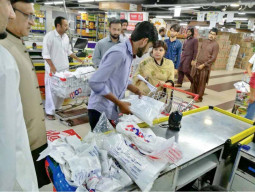
Jane Goodall, the world-renowned primatologist, has very aptly noted the irony of how “the most intellectual creature to ever walk Earth is destroying its only home”. Human-caused climate change has indeed put an immense strain on the delicate ecosystem of our planet, the consequences of which are becoming increasingly apparent.
Varied forms of human behaviour have combined to wreak havoc on the natural environment. Polluting industrialisation processes, use of fossil fuels to meet growing energy demands and creation of unsustainable food production systems are all major contributors to an ever-growing environmental crisis.
While heat-trapping gases are recognised as a major cause of global warming, focusing on land use is a still ignored, yet very important aspect of contending with climate change. The Intergovernmental Panel on Climate Change (IPCC) has just released a sobering report which highlights how current patterns of used land are not only making global warming worse, but also making food more expensive, scarcer, and less nutritious.
Land comprises only 30% of the Earth, and it is warming much faster than the rest of the planet. In turn, climate change is worsening land degradation. It has caused deserts to grow and has made forests more vulnerable to drought, fire, pests and disease.
Scientists had long thought that one of the few benefits of higher levels of heat-trapping carbon dioxide in our atmosphere was that it made plants grow more. But scientific studies are showing how high levels of carbon dioxide reduce protein and nutrients in many crops. The stability of food supply is projected to decrease as the magnitude and frequency of extreme weather events such as floods and droughts disrupt existing food chains.
Human land use is not only part of the environmental problem; it can also offer a potential solution. Rethinking our agriculture and forestry policies can become a powerful force in combatting climate change. At present, agriculture and forestry are estimated to account for about 23% of the heat-trapping gases warming the Earth (which is only slightly less than gases from automobiles, boats and planes). Add in transporting food, energy costs, and packaging and that proportion grow to over 35%.
Yet land is also a great carbon “sink” which sucks heat-trapping gases out of the air. Agriculture and forestry still pull more carbon dioxide out of the air than they put into it. However, if we continue to deforest and destroy our soils, the carbon currently being absorbed by our land will go into the atmosphere instead and make the rate of global warming even worse.
Overall, land emissions are increasing, and the aggressive cutting down of forests persists in places like the Amazon (Brazil, Colombia and Peru). Palm oil production has played havoc in tropical forested areas of Africa and Asia. It is easy for richer countries in Europe to criticize this deforestation, but even an environmentally conscious country like Germany continues to import large amounts of soy from Latin America, where forests are being destroyed to plant the crop, to feed unsustainable numbers of livestock in Germany.
If people change their diets, reducing red meat and increasing plant-based foods such as fruits, vegetables and seeds, the world can save as much as another 15% of the current emissions by mid-century. Reducing food waste can fight climate change as well given that global food waste alone accounted for 8% to 10% of heat-trapping emissions between 2010 and 2016.
If people change the way they eat, grow food, and manage forests, it could help save the planet from a dangerously warmer future. Given the interconnected nature of our global production and consumption system, however, this change needs to occur within and across all countries around the world.
Planting trees is one important part of rethinking the land use strategy, which currently seems in vogue within Pakistan. However, other issues which also merit equal attention are our agricultural and urban development strategies, which in their current form remain quite unsustainable.
Published in The Express Tribune, August 23rd, 2019.
Like Opinion & Editorial on Facebook, follow @ETOpEd on Twitter to receive all updates on all our daily pieces.





















































COMMENTS
Comments are moderated and generally will be posted if they are on-topic and not abusive.
For more information, please see our Comments FAQ